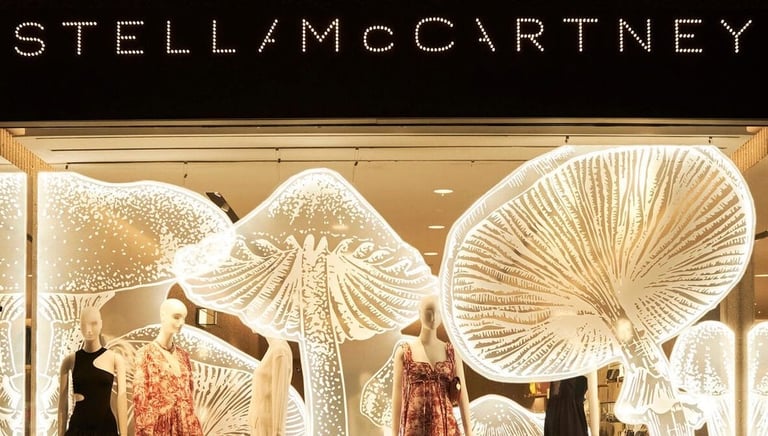Stella McCartney: Leading Sustainable Luxury Fashion
Sophia, The LuxEco Edit
10/3/20253 min read


When conversations about sustainable fashion turn to luxury, one name inevitably rises above the rest: Stella McCartney. Since founding her eponymous house in 2001, she has positioned herself as the designer who refuses compromise—both in aesthetics and in values. Unlike many brands that only recently discovered the language of sustainability, Stella McCartney’s identity has been built on it from the start.
But in 2025, what does it mean for a brand that pioneered sustainable luxury to continue leading? And what lessons can the broader industry draw from her model?
From Conviction to Industry Leadership
McCartney was one of the first major designers to ban leather, fur, and PVC outright, long before such moves became part of corporate sustainability reports. At the time, these decisions were radical—even commercially risky. Yet her collections proved that ethics and desirability were not mutually exclusive.
Over two decades later, her ethos has become an industry benchmark. Major conglomerates like Kering, once her partial partner, now run entire divisions on sustainable innovation. Stella McCartney helped set the stage, but the challenge today is not simply being first—it is being continuously innovative in an environment where sustainability claims have become crowded and contested.
(📌 Related: Circular Fashion and the Future of Luxury)
Innovation as Sustainability Strategy
Stella McCartney’s leadership lies not only in her refusal to use animal-based leathers or furs, but in her active investment in alternative materials. Partnerships with biotechnology firms have produced Mylo™, a mycelium-based leather alternative, and collaborations with Parley for the Oceans have resulted in recycled ocean plastics in accessories and sneakers.
This strategy is not without hurdles. Mycelium leather remains expensive and difficult to scale, while consumer demand often defaults to the familiarity of traditional materials. Yet the act of pushing boundaries itself is a form of leadership. By backing emerging technologies, McCartney legitimises their potential and accelerates adoption across the industry.
The Aesthetics of Integrity
Unlike some brands that bolt sustainability onto their narrative, Stella McCartney integrates it directly into design philosophy. The house is known for sharp tailoring, fluid silhouettes, and athletic-inspired luxury—designs that resonate with the quiet luxury trend yet retain a distinct identity.
From a neuroscience perspective, this matters. Consumers are more likely to trust a brand when sustainability is framed as seamless with design, rather than an external add-on. The brain responds positively to coherence; when the values match the aesthetics, credibility increases.
Beyond Materials: Systemic Thinking
Equally important is McCartney’s commitment to systemic change. The brand was an early advocate for circular fashion, experimenting with garment recycling technologies and piloting repair services. The introduction of digital IDs in garments—scannable tags that reveal sourcing and care information—demonstrates how transparency can be embedded into the user experience.
Yet challenges remain. Critics note that Stella McCartney’s prices place her far beyond the average consumer’s reach, raising questions about inclusivity. Others argue that sustainability must also confront production volumes, not just materials. These critiques are valid, and they underline a broader industry truth: no single brand can achieve sustainability alone.
(📌 Read also: Timeless Wardrobe: Integrity Over Excess)
A Cultural Symbol
For luxury fashion, Stella McCartney functions as both designer and symbol. She represents the possibility that creativity and conviction can reshape an industry. Her voice carries weight in political and business circles, from advising the UN to influencing EU textile regulations.
This symbolic capital matters. As sustainability risks devolving into greenwashing, figures like McCartney serve as touchstones of authenticity. Her longevity in the space gives credibility to the claim that luxury can be ethical—and that responsibility is not an accessory but a foundation.
Editorial Reflection
For The LuxEco Edit, Stella McCartney illustrates both the promise and the tension of sustainable luxury. Her leadership shows that aesthetic excellence and ethical conviction can be mutually reinforcing, not contradictory. At the same time, her journey highlights the structural limits of sustainability in a global fashion economy built on growth.
The lesson for fashion is clear: sustainability cannot remain a niche or a marketing label. It must be designed into every seam, every fibre, and every system. Stella McCartney has shown what that looks like. The industry now faces the question—who will follow not in rhetoric, but in practice?
🔗 Discover more at Stella McCartney Official.
